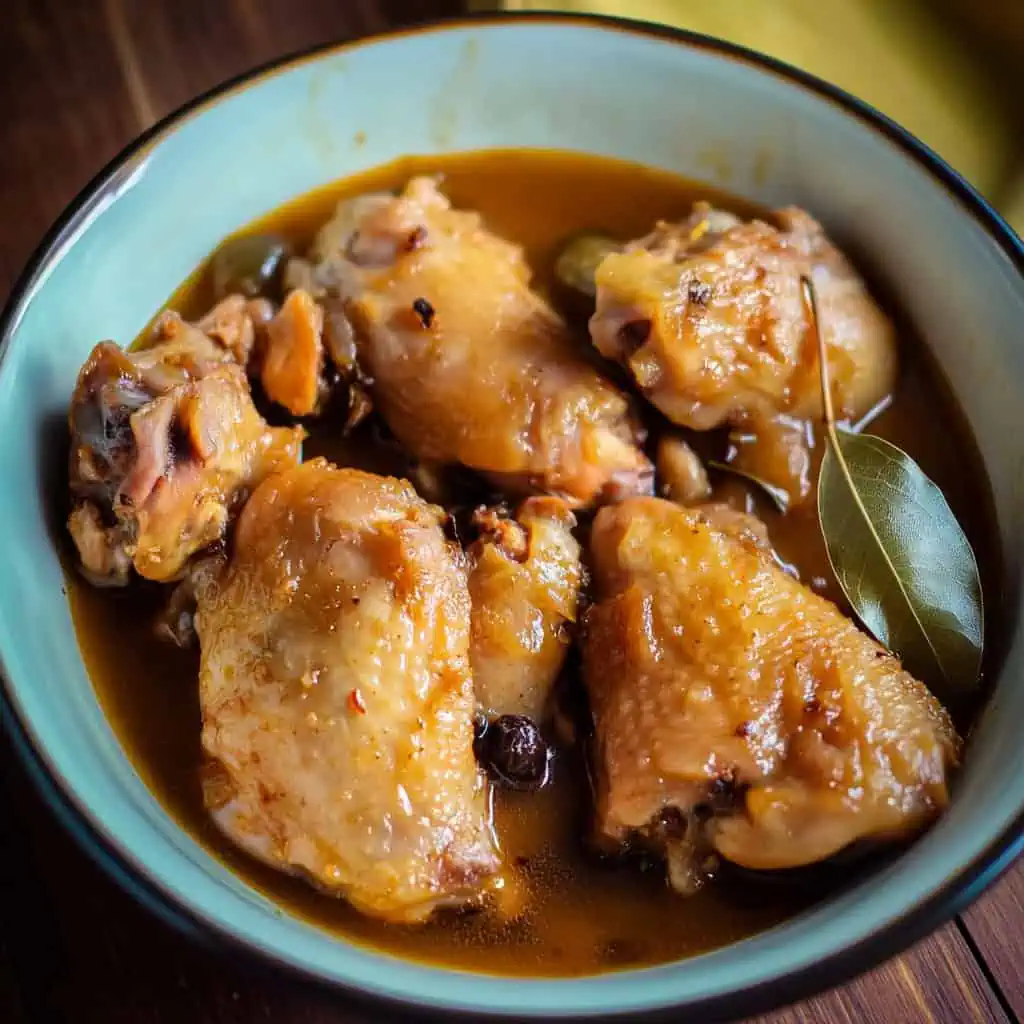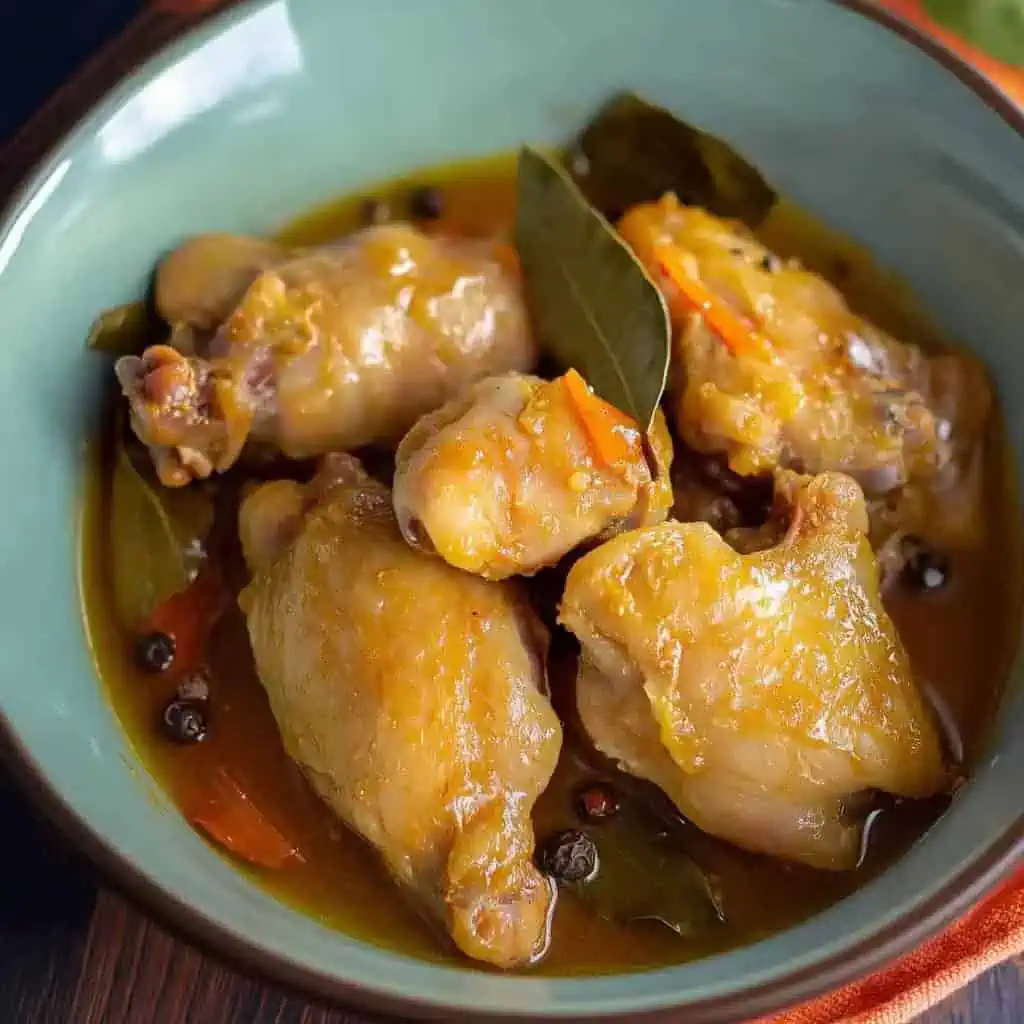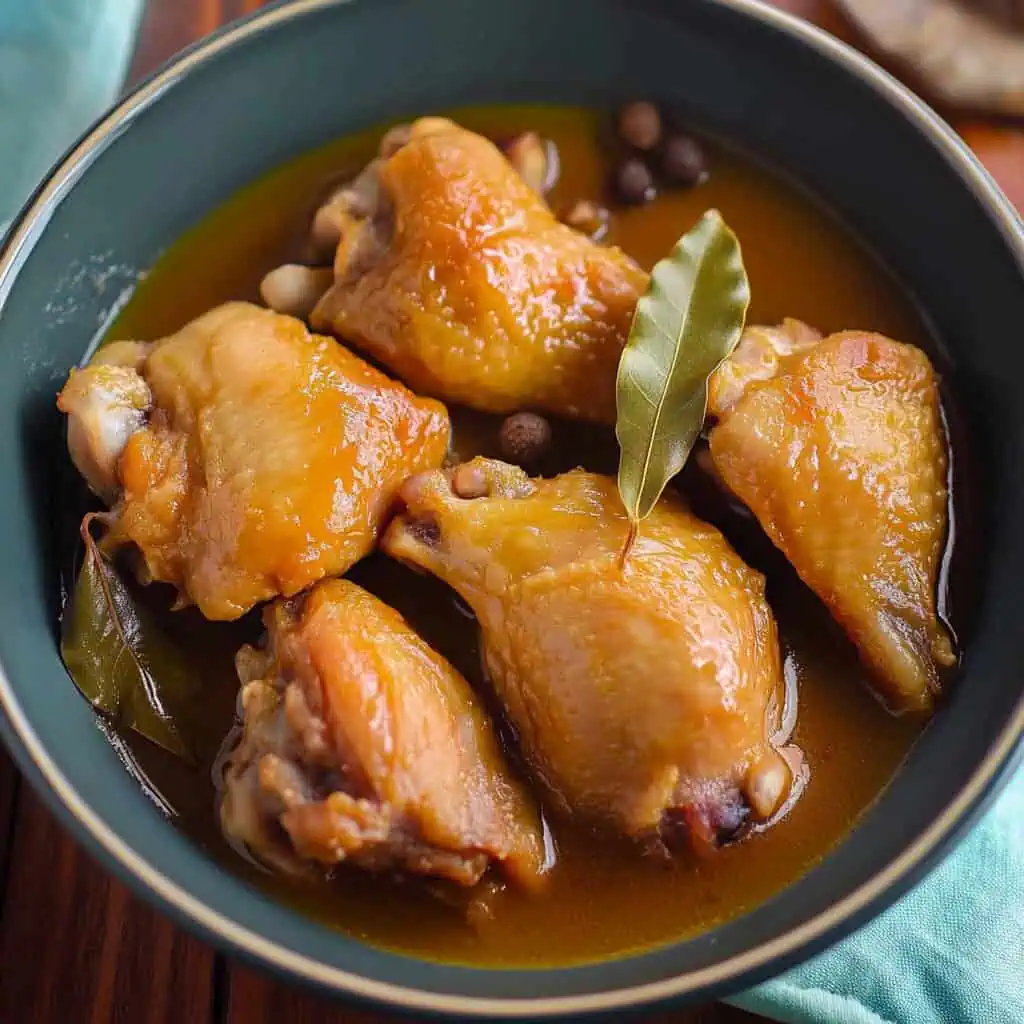You know that moment when you're craving adobo but realize you're out of soy sauce? That's exactly how this recipe was born - a happy kitchen accident that turned into something amazing!
This Adobong Manok sa Patis swaps out the usual soy sauce for fish sauce. It's got that classic adobo tang we all love, but with an extra punch of umami that'll have you reaching for seconds (maybe thirds, no judgment here).
It's actually simpler than traditional adobo but packs so much flavor, you might find yourself "accidentally" running out of soy sauce more often. Perfect for busy weeknights or when you want to impress your tita with something a little different - and hey, nobody needs to know how easy it was to make.
Jump to:

Why You'll Love This Recipe
- Ready in under an hour with minimal prep work
- One-pot cooking means easy cleanup
- Creates its own rich sauce perfect for rice
- More umami depth than traditional soy sauce-based adobo
- Naturally gluten-free and dairy-free
- Gets even better the next day
Ingredients
The ingredients in Adobong Manok sa Patis were thoughtfully selected to create a deeply flavorful dish that honors coastal Filipino cooking traditions. Fish sauce brings intense umami depth that pre-dates the use of soy sauce in Filipino cuisine, while vinegar provides essential tang and acts as a natural preservative.
Aromatic garlic and onion create a flavorful base, with bay leaves and peppercorns adding subtle complexity. This combination creates a perfect balance of salty, sour, and savory flavors that infuse the chicken completely while it simmers.
Each ingredient plays a vital role in developing the distinctive taste that makes this coastal adobo variation so satisfying when spooned over steaming rice.

- 1 whole chicken (3-4 pounds), cut into serving pieces
- 1 whole head garlic, minced
- 1 large onion, chopped
- ¼ cup fish sauce (patis)
- ½ cup white vinegar
- 1 cup water
- 2 bay leaves
- ½ teaspoon whole black peppercorns, crushed
- 1 tablespoon cooking oil
- Salt to taste
Equipment
- Large heavy-bottomed pot or Dutch oven: Provides even heat distribution and prevents burning
- Sharp knife: Essential for properly cutting chicken into serving pieces
- Cutting board: Provides a stable surface for safe food preparation
- Measuring cups and spoons: Ensures recipe accuracy
- Tongs: Helps with easily turning chicken pieces during browning
- Wooden spoon: Gentler on the chicken meat than metal utensils, preventing tearing

How To Make
- Heat your pot over medium heat and add oil. Once hot, add chopped onions and minced garlic. Cook until onions become translucent and soft, about 3-4 minutes.
- Add chicken pieces to the pot. Allow them to cook and brown on each side for approximately 5-7 minutes, turning occasionally until they develop a light golden color.
- Pour in the fish sauce and let it bubble for 2 minutes, occasionally moving the chicken to coat it well. This important step helps reduce the strong fish sauce aroma.
- Add the vinegar and do not stir for 3-5 minutes, letting it boil untouched. This prevents the vinegar from developing a bitter taste.
- Pour in the water, add bay leaves and crushed peppercorns. Reduce heat to low, cover the pot, and simmer gently for 20-25 minutes until the chicken is fork-tender.
- Taste and adjust seasoning with salt if needed. Let the dish rest for 5-10 minutes before serving to allow flavors to meld beautifully.

Tips from Lola's Kitchen
- Use native vinegar (like sukang paombong or sukang iloko) whenever possible for a more authentic flavor profile.
- Let the dish rest for at least 30 minutes before serving – the flavors develop and integrate better with time.
- Make extra sauce to use as "papaitan" (reserved sauce for enhancing future meals).
- Balance is key – the perfect adobo harmonizes sour, salty, and garlicky flavors.
- Don't rush the browning process – those caramelized bits add tremendous depth to the final dish.
- Keep the lid off during the final 5 minutes of cooking if you prefer a slightly thicker sauce.
Substitutions
- Chicken: Pork belly works beautifully, or try a chicken-pork combination for textural variety.
- Fish sauce: Light soy sauce can be used in a pinch, but reduce the amount by half and adjust to taste.
- White vinegar: Apple cider vinegar or cane vinegar make excellent alternatives with slightly different flavor profiles.
- Fresh garlic: In an emergency, substitute with 2 tablespoons of garlic powder, though fresh is strongly preferred.
- Bay leaves: A pinch of dried oregano can provide a similar aromatic quality if bay leaves aren't available.
Troubleshooting
- Too salty? Add a quartered potato to the simmering dish – it will absorb excess salt. Remove before serving.
- Too sour? Balance with a pinch of sugar or add a bit more water to dilute.
- Sauce too thin? Simmer uncovered for an additional 5-10 minutes to reduce and concentrate flavors.
- Chicken not tender enough? Continue simmering with additional water if needed until the chicken reaches desired tenderness.
- Flavors seem flat? A tiny splash more vinegar at the end can brighten everything up.
Storage & Reheating
- Refrigerator: Store in an airtight container for 3-4 days. The flavor actually improves after a day!
- Freezer: Freeze in portion-sized containers for up to 2 months.
- Reheating on Stovetop: Warm over medium heat until the internal temperature reaches 165°F (74°C).
- Microwave Reheating: Heat in 2-3 minute intervals, stirring between each to ensure even warming.
- Serving Suggestion: Add a tablespoon of fresh vinegar when reheating to refresh the flavors.

FAQ
Why shouldn't I stir after adding vinegar?
Stirring vinegar while it's cooking can develop bitter notes. Allowing it to boil untouched helps mellow the acidity naturally while preserving its tangy character.
Can I marinate the chicken beforehand?
While you can marinate for 1-4 hours, it's not traditional or necessary for this dish. The simmering process infuses plenty of flavor.
Why is my sauce not darkening like regular adobo?
This version uses fish sauce instead of soy sauce, resulting in a lighter-colored but equally flavorful sauce. The lighter color is characteristic of this coastal variation.
Can I use boneless chicken instead?
Yes, though bone-in pieces add more flavor. If using boneless, reduce the cooking time by about 5-7 minutes to prevent drying.
How can I make this dish spicy?
Add 2-4 bird's eye chilies (siling labuyo) when you add the bay leaves for a gentle heat that infuses throughout the dish.
Can I add vegetables to this dish?
While not traditional, potatoes or hard-boiled eggs can be added during the last 10 minutes of cooking for a heartier meal.
Is this dish good for meal prep?
Absolutely! In fact, it tastes even better after a day as the flavors continue to develop in the refrigerator.
Related
Looking for other recipes like this? Try these:

Adobong Manok sa Patis (Filipino Chicken Adobo with Fish Sauce)
Equipment
- Large heavy-bottomed pot or Dutch oven (for even heat distribution and preventing burning)
- Sharp knife (para sa maayos na pagkahiwa ng manok / for proper chicken cutting)
- Cutting board (Sangkalan)
- Measuring cups and spoons (Panukat)
- Tongs (for easy turning of chicken pieces)
- Wooden spoon (hindi nakakapandikdik ng manok / won't tear the chicken meat)
Ingredients
- 1 whole chicken 3-4 pounds, cut into serving pieces (1 buong manok)
- 1 whole head garlic minced (isang buong buo ng bawang, dinurog)
- 1 large onion chopped (isang malaking sibuyas, hiniwa)
- ¼ cup fish sauce patis
- ½ cup white vinegar suka
- 1 cup water tubig
- 2 bay leaves dahon ng laurel
- ½ teaspoon whole black peppercorns crushed (pamintang buo, dinurog)
- 1 tablespoon cooking oil
- Salt to taste asin
Instructions
- Begin by heating your pot over medium heat and adding oil. Once hot, toss in your chopped onions and minced garlic. Cook them until the onions turn clear and soft - this takes about 3-4 minutes.
- Now add your chicken pieces to the pot. Let them cook and brown on each side for about 5-7 minutes, turning them occasionally. You want them to get a nice light golden color.
- Pour in the fish sauce and let it bubble for 2 minutes, occasionally moving the chicken around to coat it well. This step is important as it helps reduce the strong fish sauce smell.
- Add the vinegar and - this is important - don't stir it! Let it boil without touching it for 3-5 minutes. This prevents the vinegar from becoming bitter.
- Pour in the water, add your bay leaves and crushed peppercorns. Turn the heat to low, cover the pot, and let everything simmer gently for 20-25 minutes. You'll know it's ready when the chicken is tender enough to easily cut with a fork.
- Give it a taste and add a little salt if needed. Let it rest for 5-10 minutes before serving - this helps all the flavors come together beautifully. Your adobo should have a perfect balance of sour and savory flavors, making it ideal for spooning over a plate of hot rice.
- Remember: the sauce will continue to develop flavor as it sits, so it's even better the next day!
Tips from Lola's Kitchen
- Always use native vinegar (sukang paombong or sukang iloko) for authentic taste
- Let the dish rest for 30 minutes before serving to allow flavors to develop
- Cook extra sauce for "papaitan" (sauce for future meals)
- The best adobo has a balance of sour, salty, and garlicky flavors
Nutrition
The Story Behind Adobong Manok sa Patis
Growing up in Filipino kitchens, adobo has always been more than just a dish, it's a testament to our ancestors' ingenuity in preserving food through vinegar and salt. While the classic soy sauce version reigns supreme in most households, this Adobong Manok sa Patis tells a fascinating story of coastal Filipino cooking, where fish sauce has been a staple long before soy sauce made its way to our shores.
In the coastal regions of the Philippines, particularly in fish sauce-producing provinces like Pangasinan and Navotas, patis has been the preferred seasoning for generations. This version of adobo showcases how our fishing communities have adapted the national dish to incorporate their local pantry staples, creating a variant that's lighter in color but deeper in umami complexity.
What makes this recipe particularly special is its connection to pre-colonial Filipino cuisine. Before Chinese traders introduced soy sauce to our islands, our ancestors were already creating savory dishes using patis, a fermented fish sauce that shares similarities with the ancient Roman garum. This preparation method isn't just cooking - it's a living piece of our culinary heritage.
The beauty of Adobong Manok sa Patis lies in its simplicity. Like many great Filipino recipes, it was born from practicality - using what's abundant and available. The combination of patis and sukâ (vinegar) creates a preservation method that not only keeps the meat fresh longer but also develops deeper, more complex flavors as it sits, making it a favorite for busy families who appreciate make-ahead meals.
Today, this variation of adobo represents both innovation and tradition. It's a reminder that Filipino cuisine isn't static but constantly evolving, with each region and generation adding their own twist to beloved classics. Whether you're a seasoned cook or just starting to explore Filipino cooking, this patis-based adobo offers a delicious glimpse into the rich tapestry of our culinary heritage.










Comments
No Comments